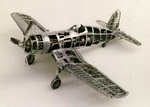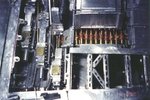GrauGeist
Generalfeldmarschall zur Luftschiff Abteilung
Came across this article...simply amazing, and in aluminium no less! 
Photo captions:
1) This 1:16 scale model is all aluminum and complete to the smallest detail. Formerly classified military manuals from WWII provided all the detail Dr. Park needed to construct each part.
2) Some of the control mechanisms in the cockpit can be seen here. Notice also the rivet detail.
3) Inside the wing, the machine gun mechanism is typical of Dr. Park's attention to detail.
All Aluminum Corsair Model by Dr. Young C. Park
Hold on to your hats, you're not going to believe this project! Dr. Young Park, a dentist in Honolulu, HI has this thing about aluminum. He has always enjoyed working with the material since making things from the scraps that were readily available from leftover aircraft after WWII. He started out to model just the vertical stabilizer of a Corsair to use on a trophy. He then made a tail section to mount it on. It looked incomplete without horizontal stabilizers, so he made those too. From there it was just one part after another working forward from the tail until he had modeled the entire aircraft. Of course he had high speed dental tools at his disposal for some of the work, but most was done with simple hand tools.
After completion of the first model, Dr. Park decided that the quality was not quite as good as it could have been with the use of better tools, so he purchased Sherline tools for his shop and started on a second model. It will be similar to the first, but the parts are being finished to an even higher level of perfection now that he has miniature machine tools at his disposal. Although the models have gotten to this stage in only a few years, Dr. Park has still devoted several thousand hours to their construction.
Much of the skin is left off the model so the inner workings can be seen. Each control surface is actuated from the cockpit by chains and levers just like the real plane. The landing gear retracts and the wings fold. Cutaways of some areas show even more detail, like what is inside the fuel tank. The machine guns in the wings are loaded with sheaths of (non-firing) bullets. Though the engine is not make to run, the level of detail on its exterior is astounding. All the aluminum skin panels are hand formed and attached with tiny aluminum rivets. The models continue to evolve as Dr. Park adds more and more detail. The second model even has a pilot figure that is also carved from solid aluminum blocks. The initial machining of the face was done with an end mill and the final carving done with high speed dental tools. Dr. Park saves the expensive diamond burrs from his dental practice when they become dull and uses them on the aluminum. (There's a tool you probably won't find in many machine shops...) After seeing his work, I know I wouldn't hesitate for a minute to let him work on my teeth. A filling or bridge must be an easy task compared to a project like this.
More details about Dr. Park and the aircraft can be found in a good article done by the Honolulu newspaper. Follow this link to READ ARTICLE. The article shows a picture of Dr. Park and gives a better idea of the small size of the aircraft. The model was also featured in the November, 2000 issue of Fine Scale Modeler, a monthly magazine by Kalmbach Publishing out of Milwaukee.
Photo captions:
1) This 1:16 scale model is all aluminum and complete to the smallest detail. Formerly classified military manuals from WWII provided all the detail Dr. Park needed to construct each part.
2) Some of the control mechanisms in the cockpit can be seen here. Notice also the rivet detail.
3) Inside the wing, the machine gun mechanism is typical of Dr. Park's attention to detail.



